
Cargadores de vehículos eléctricos
Sistema de gestión térmica de la batería
Aire acondicionado eléctrico
Aire acondicionado accionado por motor
Este cargador DC EV tiene un rango de potencia de carga de 20kW-80kW. Es compacto y flexible en su instalación..
✲ Carga de una hora: Cars agrega alrededor de 200-800 km
✲ Estándar del conector: CCS / CHAdeMO / GBT
✲ Protocolos de comunicación: OCPP1.6J
✲ Certificación de calidad: ISO 9001, CE, etc..
✲ Aplicación: Local comercial, Hoteles, Lugares de trabajo, Estaciones de carga, etc..
Los cargadores DC EV de esta página cuentan con dos tipos de montaje, ya sea Wallbox o Pedestal. Ha sido diseñado para ser compacto y ocupar poco espacio.. Puede instalar más cargadores en el mismo sitio.. Y puede cargar dos vehículos eléctricos al mismo tiempo., lo que mejora en gran medida la tasa de utilización del cargador.
Déjame darte un ejemplo para entender el concepto de 80kw.. Suponga que tiene un automóvil de pasajeros normal.. Su consumo eléctrico habitual cada 100 km es 10 grados (kWh). Para facilitar el cálculo, ignoremos la tasa de conversión. Un cargador de vehículos eléctricos de CC de 80 kW cargará 80 kWh en 1 hora. Esto es el equivalente a sumar 800 Kilómetros de autonomía para tu coche eléctrico. Si 2 Los autos se cargan al mismo tiempo., el rango se reduce a la mitad.
Video: Prueba de carga del cargador TKT DC EV
Un cargador de CC para vehículos eléctricos es un dispositivo que convierte la energía de CA de la red en energía de CC y la entrega directamente al paquete de baterías de un vehículo eléctrico para su carga.. Primero se comunica con el sistema de gestión de baterías. (BMS) del vehículo eléctrico. Luego ajusta el voltaje y la corriente de carga según el estado en tiempo real de la batería.. El módulo de protección de seguridad monitorea en tiempo real y todo el proceso de carga es muy seguro.
Los componentes principales de un cargador DC EV son: módulo de carga, sistema de control, interfaz del operador, módulo de comunicación, y dispositivo de protección de seguridad.
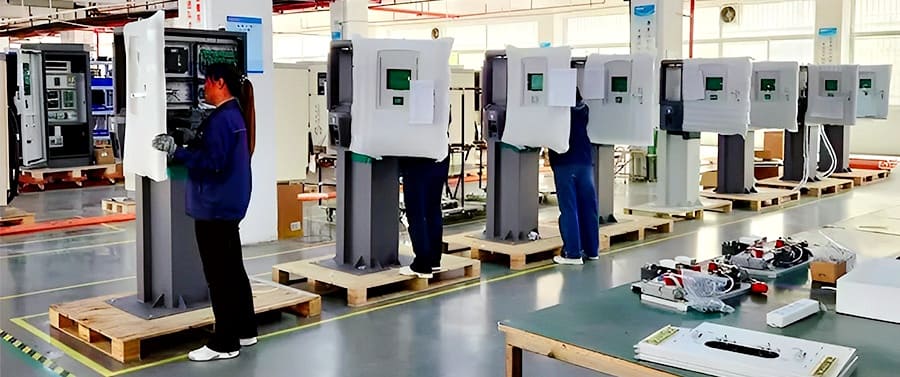
Uno de los talleres de producción de cargadores DC EV de TKT
1. Protección múltiple: protección integral para vehículos, personas y equipos.
2. Diseño modular: La actualización y el mantenimiento son flexibles y sencillos.
3. Carga rápida: Para vehículos eléctricos comunes, el tiempo de carga solo toma 60 a 90 minutos.
4. Equilibrio de carga dinámico: mejorar la eficiencia de carga y la utilización de la pila de carga.
5. Sistema de gestión avanzado: fácil de operar para los clientes. Los datos del gerente son claros..
6. Cientos de patentes: Excelente calidad, Precio pagable.
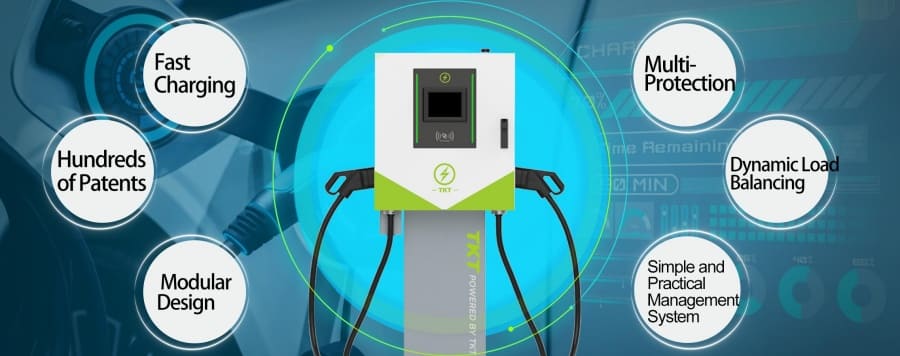
Obtenga más información sobre el 6 ventajas
1. Con OCPP integrado, El cargador se puede conectar fácilmente a nuestro sistema de gestión de carga en la nube para facilitar la operación y el mantenimiento..
2. Admite lector RFID para autenticación de usuario;
3. 8″ Pantalla táctil LCD e interfaz fácil de usar.
4. Soporte cableado / red inalámbrica LAN, 4GRAMO.
5. Admite OCPP 1.6J para pagos en línea y monitoreo inteligente.
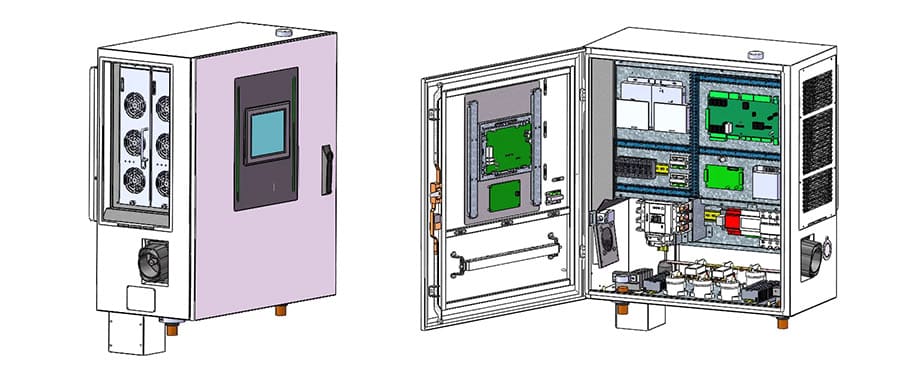
Dibujo de diseño del cargador DC EV
TKT es fuerte y tiene una amplia gama de cargadores DC EV modelos de producto. Tenemos tanta confianza en la calidad de nuestros productos que ofrecemos una garantía de 24 meses en todos los cargadores de CC.. Nuestros productos se exportan a más de 40 países alrededor del mundo, y hemos formado relaciones estables y a largo plazo con conocidos fabricantes de vehículos como BYD y Tata Motors..
| Fuerza | 20kilovatios | 30kilovatios | 40kilovatios | 60kilovatios | 80kilovatios |
| Toma de carga | 1 conector | 1 conector | 1 conector | 2 conector | 2 conector |
| Voltaje de entrada | 3-Fase 400V ±15% CA | ||||
| Conector de salida | CCS, CHAdeMO, GBT opcional | ||||
| Frecuencia de trabajo | 45~65Hz | ||||
| Factor de potencia | ≥0,99 | ||||
| Eficiencia | ≥94% | ||||
| Mostrar | 8» Pantalla táctil LCD | ||||
| Idioma | Chino, Inglés, ruso, Otros idiomas admiten personalización | ||||
| Pago | Aplicación móvil / RFID / punto de venta | ||||
| Conexión de red | 4GRAMO / Lan | ||||
| Protocolos de comunicación | OCPP1.6J | ||||
| Temperatura de trabajo | -30°C ~ +50°C | ||||
| Proteccion | IP54 | ||||
| Dimensiones (L*W*H) | 830*459*1686 milímetros | ||||
| Longitud del cable | 5 metros | ||||
| Certificado | ISO 9001, IATF16949, NTC-CE, IEC61851-1, IEC61851-23, IEC61851-21-2, etc.. | ||||
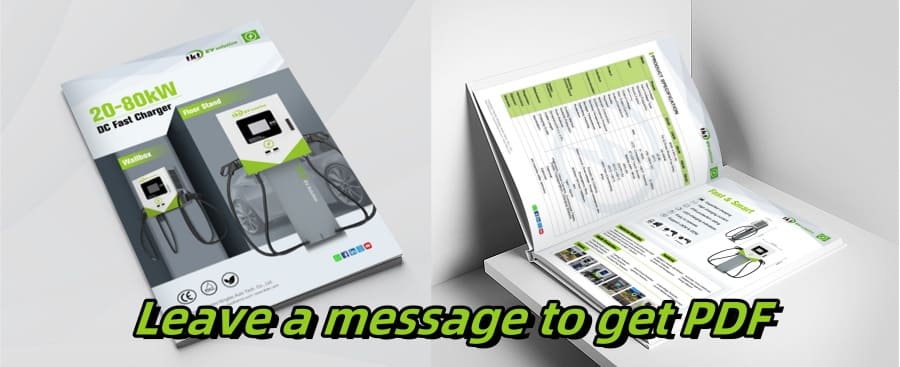
1. Soluciones de carga para todas las ubicaciones comerciales
Con la popularidad de los vehículos eléctricos, Cada vez más locales comerciales necesitan un cargador rápido de CC.. Por ejemplo, Estaciones de carga para edificios de oficinas, estaciones de carga para vehículos eléctricos en estacionamientos, estaciones de carga ev para hoteles, estación de carga del centro comercial, cargador de gasolinera, etc.. Hemos exportado a más de 40 Países y regiones, incluida Tailandia., India, Malasia, México, Alemania, y francia.
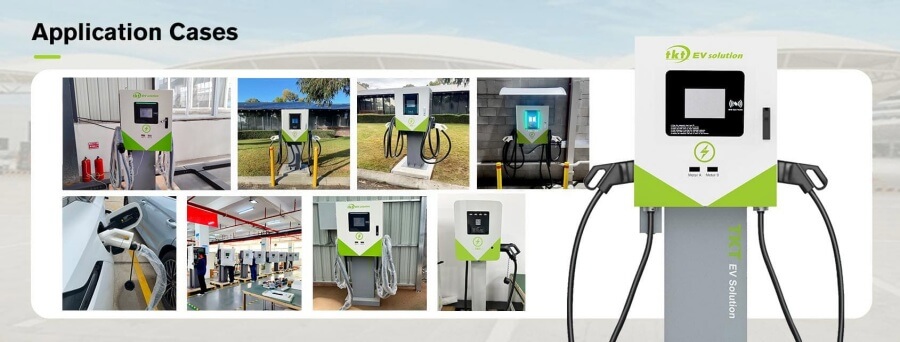
Haga clic para ver más casos en alta definición
2. Soluciones de carga para grandes flotas
Los tipos comunes incluyen el transporte público., industrias de transporte y logística. Hemos iniciado una estación de carga de autobuses eléctricos en EE. UU., estación de carga de autobuses en Canadá, Estación de carga de taxis en Australia, Estación de carga de camiones eléctricos en el Reino Unido, etc.. Nuestro cargador rápido de CC ha aumentado la frecuencia de los viajes de vehículos en más de 20%.
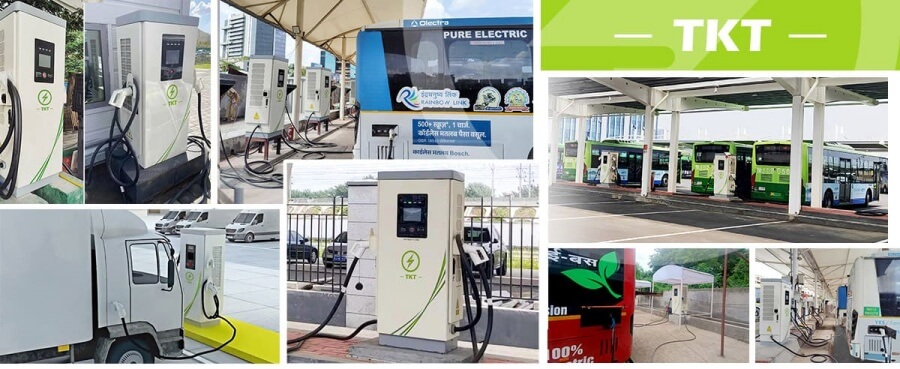
Haga clic para ver más casos en alta definición
Damos gran importancia a la calidad del producto., y realizaremos hasta 16 Inspecciones nuevamente antes de cada entrega.. Estos incluyen cableado y enrutamiento., comprobaciones de resistencia de aislamiento, Comprobaciones del disyuntor y de la función de parada de emergencia., Comprobaciones de CC de la fuente de alimentación interna, controles de pantalla táctil, comprobaciones de termistor, comprobaciones del funcionamiento del ventilador, comprobaciones del historial de carga, comprobaciones de la función de comunicación remota, y más.

Aunque la carga con CC tiene cierto impacto en la duración de la batería de los vehículos eléctricos, Este impacto se puede minimizar y prolongar la vida útil de la batería mediante una estrategia de carga razonable y técnicas avanzadas de gestión de la batería..
Se han mejorado enormemente los sistemas de gestión de baterías y las tecnologías de baterías para vehículos eléctricos modernos.. Muchos vehículos eléctricos están equipados con sistemas avanzados de gestión de batería que pueden monitorear el estado de la batería en tiempo real y ajustar la estrategia de carga para minimizar el impacto negativo en la vida útil de la batería.. Además, Algunos fabricantes de automóviles ofrecen modos de carga rápida y lenta para que los usuarios elijan, para que puedan seleccionar el método de carga adecuado según sus necesidades y situación real.
La carga CC para vehículos eléctricos es un método de carga eficiente. Convierte corriente alterna (C.A.) de la red a corriente continua (corriente continua) a través de un cargador de CC y lo transmite directamente a la batería del EV. La carga rápida se logra mediante el método anterior..
Generalmente, esto no es posible. Esto se debe a que el voltaje en casa suele ser 220 V. Pero el voltaje mínimo requerido para un cargador DC EV es 380 V. Esto generalmente se usa en aplicaciones comerciales.. Además, el tiempo promedio de estacionamiento en una casa es largo, cargar con un cargador AC EV es suficiente para llenar.
1. Acceso a la red y conversión de corriente alterna.
La red externa proporciona alimentación CA trifásica de 380 V al cargador de CC. La alimentación de CA se convierte en alimentación de CC mediante el módulo de carga dentro del cargador de CC..
2. Coincidencia y comunicación de parámetros de carga:
El cargador de CC se comunica con el sistema de gestión de baterías. (BMS) del EV para conocer todo el estado de la batería. Luego, según la información proporcionada por el BMS, el cargador ajusta el voltaje y la corriente de salida en tiempo real.
3. Transmisión y carga de CC:
El cargador de CC transmite energía de CC directamente a la batería a través del arnés de alto voltaje y la pistola de carga de CC.. De este modo, el tiempo de carga se reduce significativamente..
4. Monitoreo y protección del proceso de carga:
Durante todo el proceso de carga, el cargador monitorea el voltaje de la batería, actual, Temperatura y otros parámetros en tiempo real para garantizar la seguridad del proceso de carga..
5. Finalización y liquidación de cargos:
Cuando la batería alcanza el valor preestablecido o está llena, el usuario puede ver la información de carga a través de la interfaz del cargador y realizar pagos y liquidaciones.
TKT EV Solution fue fundada en 1998. Hasta ahora, Ha obtenido muchos certificados de calidad como ISO9001.:2015, IATF16969:2016, CE, EMI/CEM, etc.. Y posee más de 100 patentes relacionadas.
estaciones de carga dc ev, cargador rápido ev dc, cargador ev dc, carga de vehículos eléctricos CC, cargador dc para ev, estación de carga dc ev, cargador rápido dc para ev, estaciones de carga ev dc, cargador dc ev, estaciones de carga rápida ev dc, 22cargador kw dc ev, 30cargador kw dc ev, fabricantes de cargadores dc ev, precio del cargador dc ev, cargador rápido dc ev, cargador rapido dc ev.
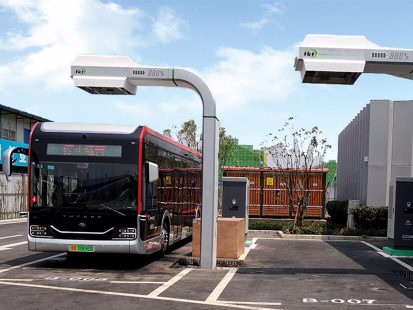
Un artículo que le informa sobre los tipos comunes de estaciones de carga de autobuses eléctricos.. ¿A qué debe prestar atención al planificar el diseño??
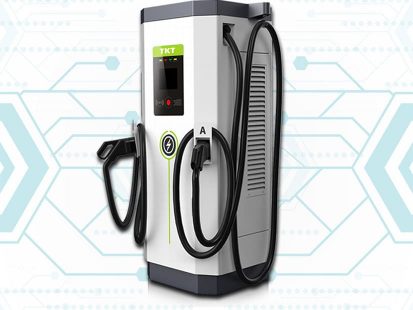
Introducción a los cargadores de CC. Incluye lo que es un cargador DC., cómo elegir un cargador de CC, visitas a la fábrica y más!
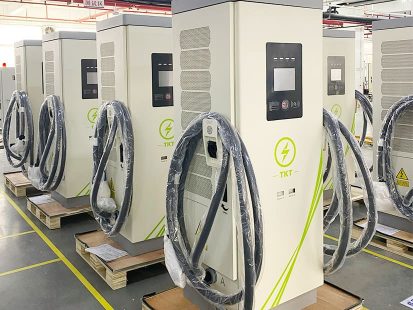
Cubre principalmente los conceptos básicos de las estaciones de carga rápida y una introducción a los puntos fuertes de los fabricantes de cargadores TKT DC ev..